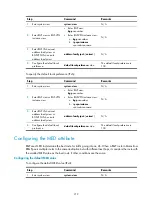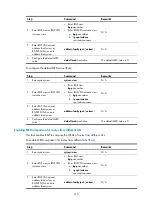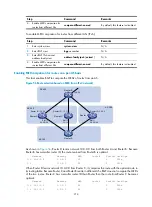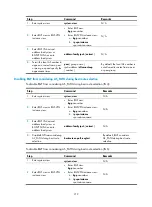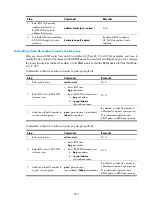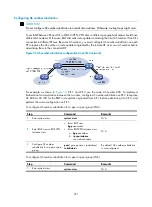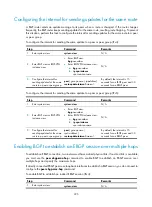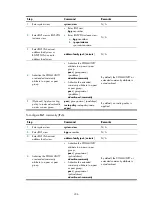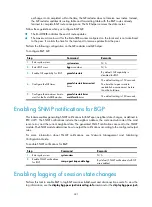
226
Step Command
Remarks
2.
Enter BGP view or BGP-VPN
instance view.
•
Enter BGP view:
bgp
as-number
•
Enter BGP-VPN instance view:
a.
bgp
as-number
b.
ip vpn-instance
vpn-instance-name
N/A
3.
Enable BGP to establish an
EBGP session to an
indirectly-connected peer or
peer group and specify the
maximum hop count.
peer
{
group-name
|
ip-address
}
ebgp-max-hop
[
hop-count
]
By default, BGP cannot establish
an EBGP session to an
indirectly-connected peer or peer
group.
To enable BGP to establish an indirect EBGP session (IPv6):
Step Command
Remarks
1.
Enter system view.
system-view
N/A
2.
Enter BGP view or BGP-VPN
instance view.
•
Enter BGP view:
bgp
as-number
•
Enter BGP-VPN instance view:
a.
bgp
as-number
b.
ip vpn-instance
vpn-instance-name
N/A
3.
Enable BGP to establish an
EBGP session to an
indirectly-connected peer or
peer group and specify the
maximum hop count.
peer
{
group-name
|
ipv6-address
}
ebgp-max-hop
[
hop-count
]
By default, BGP cannot establish
an EBGP session to an
indirectly-connected peer or peer
group.
Enabling immediate reestablishment of direct EBGP
connections upon link failure
When the link to a directly-connected EBGP peer goes down, the router does not reestablish a session to
the peer until the hold time timer expires. This feature enables BGP to immediately recreate the session
in that situation. When this feature is disabled, route flapping does not affect EBGP session state.
To enable immediate reestablishment of direct EBGP connections:
Step Command
Remarks
1.
Enter system view.
system-view
N/A
2.
Enter BGP view.
bgp
as-number
N/A
3.
Enable immediate reestablishment of
direct EBGP connections upon link
failure.
ebgp-interface-sensitive
By default, this feature is
enabled.

